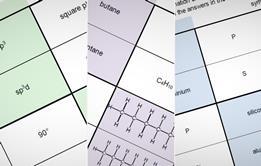101 sudoku-style chemistry puzzles with printable worksheets and answers to engage your students and consolidate their knowledge about key topics
Gridlocks are a fun and stimulating way for students to learn the facts they need in chemistry. Discover 101 printable puzzles with answer sheets, covering core topics for ages 11–14, 14–16 and 16+.
Download the puzzles for each age group below, or read on to find out:
- How gridlock puzzles work
- How you can use the puzzles in your teaching
- What your students can learn
Download the puzzles
Browse, print and download the puzzles for your students’ age group:
11–14 years | 14 –16 years | 16–18 years
Each download includes a series of puzzles focusing on a particular topic, with a printable student worksheet and answers.
How do gridlock puzzles work?
- Students begin by filling in a table to review the key ideas they need to complete the puzzles. The table contains information about a group of objects, concepts or things related to the chosen topic. To complete the table, students identify items in this group or match them with further information, data or examples.
- After filling in the table, students use this information to complete the gridlock puzzles that follow in the worksheet.
Completing the puzzles
- Each puzzle features a 4 x 4 grid divided into rows, columns and four 2 x 2 boxes.
- The objective is to fill in the grid using information from the table at the top of the worksheet, so that each row, column and 2 x 2 box contains only one reference to any single item (or row) from the table.
- Each 2 x 2 box is labelled using headings from the information table. These headings tell students what type of information should be used in that box.
- Each puzzle includes instructions telling students whether to use the whole information table, or only a part of it.
How can I use these puzzles in my teaching?
You can use gridlock puzzles during lessons or set them as homework. They are designed as follow up activities to consolidate students’ knowledge, rather than as introductions to a topic. Ideally, students should have met at least some of the data the gridlock puzzles are based on already.
The worksheets are simple to set and can readily be peer or self assessed. During lessons, the puzzles can be used flexibly as part of an individual, group or class-based activity. You can also add an extra element of competition or challenge. For example, set a target time and invite students to try to beat the clock, or encourage groups of students to see who can solve the most.
What will my students learn?
Topic knowledge
Each puzzle focuses on a topic appropriate to 11–14, 14–16 or 16–18 year old students. To solve the puzzle, students need to engage with the factual information the gridlock is based on, recalling the relationships between ideas and data established in the first part of the activity. For example, they need to recall that three electron pairs corresponds to trigonal planar geometry, or that sulfuric acid forms sulfate salts.
As they work on the puzzles, students will find themselves referring to the initial data repeatedly, gradually consolidating their knowledge of the relevant facts.
Problem-solving and thinking skills
Gridlock puzzles give students a problem-solving context for their learning, promoting engagement and offering students a sense of satisfaction in completing the grid. The puzzles also develop some important thinking skills, as students must use logical reasoning to survey the data given in the gridlock and determine which squares can be filled in.
Additional information
This resource was originally part of the Gridlocks microsite, produced by the Royal Society of Chemistry with support from the Wolfson Foundation.
Gridlocks: 101 printable chemistry puzzles

Explore these sudoku-style chemistry puzzles with printable worksheets and answers, and discover how they can be used to engage your students with key topics.


























2 readers' comments